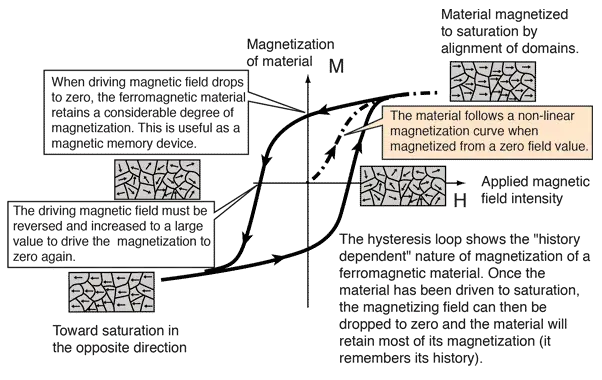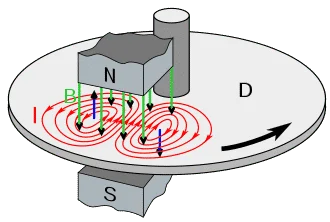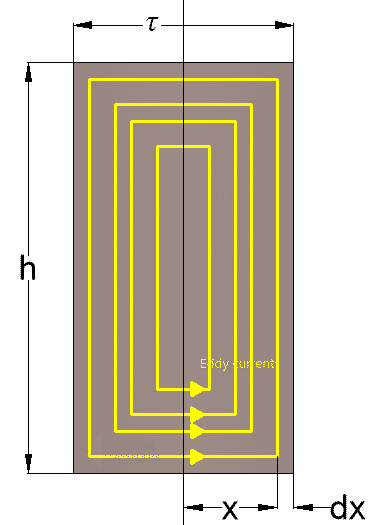In electric machines, a varying magnetic field causes eddy currents in all metallic parts and hysteresis in ferromagnetic core. The losses caused due to eddy currents are known as eddy current loss and that caused due to hysteresis is known as hysteresis loss. In the following sections, we will learn, eddy currents, the phenomenon of hysteresis, hysteresis, and resulting losses in detail. You will be able to understand eddy current losses, hysteresis losses, factors affecting them, and ways to reduce them.
Eddy Currents
What are eddy currents?
When a conductor is placed in a varying magnetic field, loops of electric currents are induced in it by the magnetic field. These currents are known as eddy currents. Eddy currents are induced whenever there is a relative motion between the magnetic field and the conductor. This relative motion may be in the form of varying magnetic field or a constant magnetic field acting on a moving conductor.
Eddy currents flow in circular loops within the conductor itself, in the direction perpendicular to the magnetic field. According to Lenz’s Law, the induced eddy currents generate another magnetic field so as to counter the actual magnetic field. This action resists the actual current flow in the conductor resulting in power loss in the form of heat. In AC motors, alternators, and transformers, eddy currents cause power loss in the core.
The heating property of eddy currents is used in induction heating. Other applications of eddy currents includes, but not limited to electromagnetic braking, metal detection, magnetic levitation, vibration & position sensing and non-destructive sensing.
Eddy current loss
As mentioned above, the power losses in conductors and ferromagnetic cores are collectively known as Eddy current losses. Eddy current loss is essentially an I2R loss caused within a conductor caused resistance offered by the conductor to the flow of current. This loss is further increased by the temperature rise.
Derivation of expression for eddy current loss
To derive the formula of eddy current, let us consider a solid core made by binding together thin sheets of steel (Figure: A). Let L be its length and h be its height of the core. Let us pull a thin sheet of thickness ‘τ’ out of the solid core. Figure B shows the side view of the sheet. Let us assume that the plate is placed in a sinusoidal magnetic field ‘b’ that acts perpendicular to the plate.
b = Bmax Sinωt
This changing magnetic field induces eddy currents in the thin plate. A few eddy currents loops are represented in the figure: A as yellow rectangles. Let us imagine the outermost loop of eddy current which is at a distance x from the origin and has its dimensions equivalent to that of the metal plate. Let dx be the thickness of this loop.
The area of the outermost eddy current loop = 2hx
Total flux crossing the loop = Bmax 2hx Sinωt =2hx Bmax Sinωt
Flux crossing the loop induces a certain amount of voltage which is given by the following equation:
Total resistance offered by the plate to the eddy current loop
Since we are considering thin sheets of laminations, meaning τ is very small so is the distance x. Therefore:
For detailed explanation about the formulation of resistance refer: What is Resistance?
Total power loss in the sheet due to eddy currents can be calculated from the formula below:
In the above equation, denotes the volume of the thin plate. To find eddy current loss in a unit volume of the sheet,
Formula for eddy current loss
In the above section, we have derived a formula for eddy current loss in a unit volume of steel. The total losses due to eddy currents can be derived from the following formula:
Where,
- Ke is the eddy current constant.
- Bmax is the maximum flux density.
- f is the frequency of the induced voltage.
- V is the volume of the material.
From the above expression it is understood that the eddy current loss is directly proportional to the square of frequency, flux density and thickness of the sheet.
Reduction of eddy current loss
From the above equation, it can be understood that the eddy current loss is directly proportional to the square of the thickness of the sheet. Hence the eddy current loss can be reduced in transformers, electric motors and alternators by using thin electrically insulated plates stacked together to form a core instead of solid ones. By doing so, eddy voltages can be reduced and the resistance to eddy currents can be increased which will finally result in lower core losses in the machines.
Hysteresis
What is hysteresis effect?
Hysteresis is the inability of molecules in a ferromagnetic material to rapidly change their magnetization in accordance with the change in an applied magnetic field. For example, if a ferromagnetic material is placed in an alternating magnetic field, the magnetization in that material will follow a path as shown below:

Hysteresis loss
Hysteresis can result in energy loss in the ferromagnetic cores of electric machines. This is because the alternating current changes its direction of flow constantly and therefore the direction of the magnetic field produced by them. This forces the molecules in the core to move to change their alignment in the proper direction. During this movement, these molecules collide with each other and cause friction and heat. The energy loss caused due to the friction of molecules in the core is known as hysteresis loss.
In addition to that the magnetization of the core lags behind the magnetic field produced by the AC power. The magnetization of core typically follows the curve shown in the above picture.
Steinmetz’s empirical formula for hysteresis loss
Charles Steinmetz, a German-American Electrical Engineer, conducted several experiments on different ferromagnetic materials and coined an empirical formula for calculating hysteresis loss analytically.
Where kh is the coefficient of hysteresis of the ferromagnetic material, f is the frequency of power supply in hertz, Bmax is the maximum flux density in weber/m2 and volume of the ferromagnetic material in m3. As you see the hysteresis loss increases with an increase in frequency. It highly depends on the material of the core.
Difference between hysteresis loss and eddy current loss
The major difference between hysteresis loss and eddy current loss are tabulated below:
| Property | Hysteresis Loss | Eddy current loss |
|---|---|---|
| Phenomenon | Hysteresis loss is caused due to molecular friction in a ferromagnetic material, under alternating magnetic field. | Eddy current loss us caused due to the induction of eddy current in the core and conductors held in magnetic field. |
| Formula |  | |
| Occurs in | Hysteresis loss occurs in the core of an electric machine. | Eddy current loss occurs in the core, conductor and body of an electric machine. |


